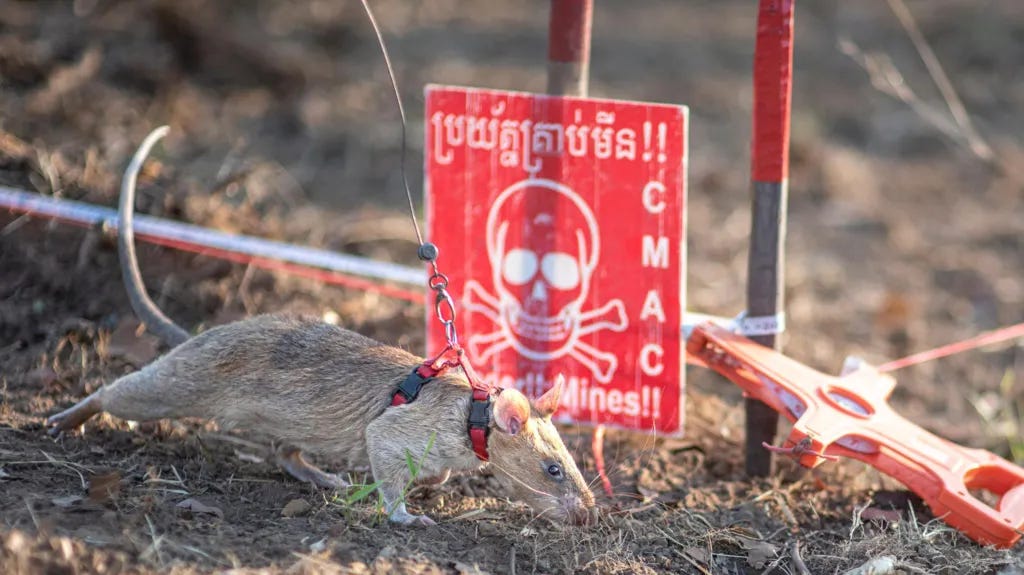A Catchup Dog Shirt From My Vacation
It will be the only one, unless I get good bear, moose, or elk photographs.
Good Evening:









I am on vacation, and I am religiously not doing any work. Like none. I’m not doing the show. I’m not doing any non-emergency Lawfare work. I’m not writing my column. (The Situation continues tomorrow, but my engagement with The Situation doesn’t continue until a week from tomorrow.)
But, I am making two exceptions. I’m planning to catch up on some reading and some back emails. And I owe ya’ll a catch-up dog shirt to, well, catch up on things I meant to do before I left on Friday.
So, after today’s seven mile hike and before today’s dinner atop a mountain, here you go. You will only hear from me again before 8:00 am on June 23 if I get good photographs of moose, elk, or bear—in which case a special dog shirt may be in order.
Thursday on #DogShirtTV, it was a revolutionary show, folks, and revolutions are messy. I was once again on a train and only intermittently connected to Riverside, so the estimable Holly Berkley Fletcher took over, monologuing about parenthood, terrible resorts, Swahili, exercise during the summer, and everything else she could come up with. She’s a great American—and folks, improvisation is really hard:
By contrast, on Friday, #DogShirtTV was running like a well-oiled machine. The estimable Holly Berkley Fletcher and I discussed what was known about the Israeli strikes on Iran as of 8:00 am Friday morning. It may be a bit out of date by now, but actually not really. It’s still a great discussion:
The Last Few Days On Lawfare
Compiled by the estimable Olivia Manes
What to Watch for in Abrego Garcia’s Hearing on Potential Pretrial Detention
James Pearce described how Kilmar Abrego Garcia’s hearing Friday in Tennessee would likely unfold, including the government’s request for pretrial detention. Pearce explains that, rather than argue with the question of detention itself, the defense’s case will likely hinge on whether a detention hearing should be held in the first place:
Unless the government succeeds in establishing that a detention hearing is warranted, the detention “hearing” will end before it begins. That appears to be Abrego Garcia’s primary strategy. Beyond arguing that no detention hearing is warranted, his response to the government’s motions offers no explanation for why, if the court does consider whether any conditions of release would reasonably assure his appearance and the community’s safety, he should be permitted to remain out of custody.
Understanding the Protective Power
Chris Mirasola unpacks the Department of Justice’s assertion of the inherent presidential power to protect federal functions, persons, and property as justification for the ongoing military deployment in Los Angeles. Mirasola explains that the history of presidential use of the protective power fails to establish a consistent principle for its invocation, and suggests that there is very little in the text of the constitution itself to suggest such an inherent authority—especially given its incongruence with statutory prohibitions on the domestic use of military force:
First, as noted above, no president so much as intimated an understanding of Article II authority similar to that which underpins the protective power until the mid-1800s. Corwin’s treatise, for example, misses at least three instances in which presidents George Washington, John Adams, and Thomas Jefferson relied on explicit statutory authority for domestic military deployments. Corwin also mistakenly asserts that Jefferson’s 1808 use of the military to enforce the Embargo Act must have been taken without statutory authority (there were at least four plausible statutory bases in effect at the time).
Even when President Fillmore first asserted this theory of inherent authority in 1850, the Senate Committee on the Judiciary responded that “[w]hen occasions arise (which must necessarily be rare) where the civil power proves inadequate to maintain the law, the President is authorized [by antecedents to the Insurrection Act] to call forth and employ, in the manner prescribed by these acts, the militia of the States … to suppress insurrections, and to enforce the due execution of the laws.”
Presidential Criminal Immunity: A Rule-of-Law Threat Beyond the Oval Office
Aziz Huq considers the far-reaching consequences of the Supreme Court’s presidential immunity decision in Trump v. United States. Huq contends that the Court’s reasoning—which anticipated “routine” partisan prosecutions without some form of presidential immunity—was flawed, and maintains that the decision has corroded respect for rule of law throughout the executive branch:
The judicial innovation of presidential immunity from criminal prosecution rested upon consequentialist grounds. For a majority of the Court, it appeared to be justified by the large costs of political prosecution; the benefits of warranted indictments seemed worth foregoing. Once we shift the analytic lens from the person of the president to the larger context of the executive branch, though, it becomes clear that matters are not so simple. Viewed in this wider context, the benefits of immunity are far more meager than the justices allow—and in large part arise out of recent doctrinal changes the justices themselves have made. In contrast, immunity’s costs are substantial. These come into view, however, only through an appreciation of how the formal prohibitions of the criminal law are entangled with the informal constraints generated through norms, beliefs, and dispositions. Put these findings together, and the conclusion is clear: Presidential immunity is a democratic catastrophe.
The Same Old Fantasies Behind AI and New Technology
Henry Farrell reviews Adam Becker’s “More Everything Forever: AI Overlords, Space Empires, and Silicon Valley’s Crusade to Control the Fate of Humanity.” Farrell finds Becker’s analysis of the philosophies and narratives underpinning conceptions of AI compelling, providing insight into the gap between speculative visions of an AI-driven future and the reality of the technology as it exists today:
Becker treats the aspiring magi of AI seriously, while arguing that they are terribly wrong. Long before models like ChatGPT, gurus like Yudkowsky, the recently deceased computer scientist and science fiction writer Vernor Vinge, and the futurist Ray Kurzweil, created a loosely shared vision of what AI might do. They hoped for a future where humanity might use AI to turn stars and even galaxies into resources to be used for human purposes, or feared one in which humanity might become the resources to be burned up and discarded by feral AI that transcended its creators and developed its own goals. The result, Becker says, is a confidence that technology can cure all ills, and a singular vision of an “immortal future in space,” with limitless energy, limitless time, and unbounded resources. The truth, he says, is that it is through acknowledgment of our physical limitations that we can understand the actual variety of political possibilities that we have, as we are forced to confront the difficult problems that the dreamers might prefer to wish away.
Trump Scales Back Biden's Product Security Demands
In the latest edition of the Seriously Risky Business cybersecurity newsletter, Tom Uren discusses a June 6 executive order signed by President Trump that would roll back American cybersecurity efforts, a recent OpenAI report examining how the platform was used in a North Korean IT worker scam, and a series of classified documents stolen from Russia's Federal Security Bureau by an online crime group that warns of the security threats posed by China:
An executive order signed by President Trump has scaled back the U.S. government's cybersecurity ambitions. It has dropped a range of provisions that would encourage organizations to adopt more stringent security standards.
The order largely takes aim at directives issued in January of this year by then-President Biden. One part of that January order stipulated that the government "identify a coordinated set of practical and effective security practices to require when it procures software" and that vendors follow those practices. Trump's order keeps the standards development part but ditches the need for vendors to actually adhere to them.
Understanding Conflict Through Satellite Imagery
David Mansfield suggests that satellite imagery can provide unique insights into the causes of global conflict, enabling better policy solutions for its prevention and mitigation. Mansfield uses his research on the May 2023 conflict at the Iran-Afghanistan border as a case study, demonstrating that the discourse surrounding conflict can often obscure nuance and preclude meaningful solutions.
Rather than focusing on the rhetoric surrounding the dispute, our research revealed novel insights into the conflict by focusing on concrete facts that could be observed through satellite imagery. Our research pointed to a more localized dispute about border management and the challenges of recalibrating cross-border relations following the collapse of the Afghan Republic and the subsequent Taliban takeover, and revealed far more pervasive issues with the widespread and unsustainable exploitation of groundwater across the Helmand River basin.
Podcasts
On Lawfare Daily on Thursday, Renée DiResta sits down with Clay Risen to talk about his book, “Red Scare: Blacklists, McCarthyism, and the Making of Modern America.” They discuss the erosion of civil liberties during the Red Scare, the role of political opportunism during the era, and the parallels that can be drawn to the modern day:
On Lawfare Daily on Friday, Scott R. Anderson sits down with William Banks of Syracuse University College of Law, Laura Dickinson of the George Washington University Law School, and Chris Mirasola of the University of Houston Law Center to discuss Trump’s deployment of military troops to Los Angeles. They consider the legal constraints the administration may face, the fate of California’s lawsuit, and implications for domestic deployments elsewhere:
Videos
On Friday at 4:00 pm Eastern time, I sat down with Anna Bower, Quinta Jurecic, Roger Parloff, and James Pearce to discuss the status of the civil litigation against the Trump administration, including the Thursday hearing on California’s lawsuit challenging the federalization of National Guard personnel, and a judicial ruling on the validity of the Alien Enemies Act proclamation:
Announcements
Lawfare is hiring a new full-time senior editor based in Washington, D.C. The senior editor will report to the editor in chief and executive editor on all editorial duties. Responsibilities of the role include producing original content such as articles and podcasts, contributing analysis of key issues, and more. Applications will be considered on a rolling basis. See how to apply here.
Today’s #BeastOfTheDay is Ronin, an African giant pouched rat who earned a world record for landmine detection back in April:
A landmine-detecting rat in Cambodia has set a new world record to become the first rodent to uncover more than 100 mines and other deadly war remnants.
Ronin, an African giant pouched rat, has uncovered 109 landmines and 15 items of unexploded ordnance since 2021, charity Apopo, which trains the animals, said in a statement.
…
Apopo, which is based in Tanzania, currently has 104 rodent recruits, or HeroRATS, as the non-profit likes to call them.
The rats are trained to sniff out chemicals that are found in landmines and other weapons abandoned on battlefields. Because of their small size, the rats are not heavy enough to detonate the mines.
The rats can check an area the size of a tennis court in about 30 minutes, the charity says, whereas a human with a metal detector might take four days to clear the same land.
In honor of today’s Beast, donate to today’s Cause of the Day!
The Cause Of The Day
Today’s Cause Of The Day is APOPO, an organization dedicated to training rats and dogs for various crucial projects in underserved countries worldwide. This includes the mine-detection rats in Cambodia, as well as in Angola, Sudan, Azerbaijan, Senegal, and Zimbabwe, but also a team of mine-detection dogs in Ukraine, tuberculosis sniffing rats in Tanzania and Ethiopia, and a new program in Turkey using rats to detect wildlife smugglers. Personally, I find the TB detection rats most impressive. It takes a lab technician several days to test 100 sputum samples for TB, but a trained rat can screen the same number of samples in 20 minutes.
You can learn more about APOPO’s work from their 2024 annual report, including both important details about their work across the globe and internal statistics about the number of banana rewards issued to rats during mine-detection training last year (16,046).
See you in a week!
If at any point during that week, you get curious about what’s below this mysterious line, you know what to do:
Keep reading with a 7-day free trial
Subscribe to Dog Shirt Daily to keep reading this post and get 7 days of free access to the full post archives.





